Far Transfer Effects of Multi-Task Gamified Cognitive Training on Simulated Flight: Short-Term Theta and Alpha Signal Changes and Asymmetry Changes
Abstract
1. Introduction
2. Materials and Methods
2.1. Multi-Task Gamified Cognitive Training (MTGCT) Method Design
2.2. Experimental Protocol
2.3. Participants
2.4. Data Analysis Methods
3. Results
3.1. Analysis of Behavioral Data
3.1.1. Statistical Analysis of Traditional Cognitive Test Scores
3.1.2. Statistical Analysis of Simulated Flight Operation Performance
3.2. EEG Signal Analysis
3.2.1. Full-Band Analysis
3.2.2. Analysis of θ Band PSD Relative Band Ratio Changes
3.2.3. Analysis of θ Band Asymmetry
3.2.4. Analysis of Band PSD Relative Band Ratio Changes
3.2.5. Analysis of α Band Asymmetry
4. Discussion
5. Limitations and Future Research
- The study included a small sample size of male university students, all of whom lacked flight experience. Although these settings are designed to more easily control the laboratory environment and eliminate variables arising from gender differences, cultural differences, and differences in flying experience, they do indeed severely limit the generalizability of the research findings. Therefore, future research should expand the sample size and include professional pilots as participants to verify the applicability and effectiveness of this study’s results in a broader population;
- After screening the 46 recruited subjects, there were 9 remaining in the CG and 19 remaining in the TG. During the experiment, we implemented strict control over experimental conditions and unified execution standards. However, due to the instability of performance in flight operation tasks, most participants in the CG were unable to meet the data recording standards or complete the tasks during the post-test or tracking test phase. Although this indirectly indicates that cognitive training generally improved the stability of participants’ operations, this limitation should be taken into full account when interpreting the results. Future research should consider the issue of sample attrition by increasing the sample size during initial recruitment or promptly supplementing participants to ensure balanced group sizes and obtain more reliable results;
- Due to the participants’ lack of flight experience, the simulated flight tasks in this study were relatively simple. This may restrict the far transfer and generalization capabilities of MTGCT to real-world complex flight tasks. It remains to be explored whether the cognitive improvements from visuo-spatial attention and working memory MTGCT can transfer to more complex flight tasks, such as dual-task or multi-task operations and flying in adverse weather conditions. Future research should increase task complexity to verify MTGCT’s transferability and generalization performance in real-world scenarios, thereby enhancing the study’s ecological validity;
- This study only examined changes in simulated flight task performance and EEG data characteristics before and after training. The neurophysiological changes during the training process were not thoroughly analyzed. Future research should include intermediate testing phases to explore the detailed evolution of EEG signal characteristics throughout the training period, thereby gaining a more thorough understanding of the dynamic effects and mechanisms of MTGCT;
- The study did not analyze the specific EEG frequency band changes from traditional cognitive tests during the pre-test, post-test, and tracking test phases, and the analysis of behavioral data was also not thorough enough. In particular, the N-back test does not distinguish the difficulty of the task. In this study, we prefer to analyze data directly related to the simulated flight task to explore the far transfer effects of MTGCT. Future research should further analyze data from traditional cognitive tests to enhance and expand the theoretical foundation from near transfer to far transfer;
- The study administered an 11-day MTGCT, with daily training comprising 30 min of visual-spatial attention training and 30 min of working memory training. The study did not sufficiently investigate different training dosages, such as training frequency, duration, and intensity. Future research should consider setting different training dosage groups to comprehensively explore the impact of varying dosages of MTGCT on performance enhancement. Additionally, future studies should account for individual differences in training dosage effects, such as age differences and cognitive sensitivity variations across a broader population;
- The 14-day retention period after training is relatively short, limiting the ability to assess long-term effects maximum duration of neurophysiological changes caused by MTGCT. Future studies should extend the experimental period to more comprehensively evaluate the long-term efficacy of cognitive training, ensuring the durability and stability of the MTGCT in practical applications.
6. Conclusions
Author Contributions
Funding
Institutional Review Board Statement
Informed Consent Statement
Data Availability Statement
Conflicts of Interest
References
- Walmsley, S.; Gilbey, A. Cognitive biases in visual pilots’ weather-related decision making. Appl. Cogn. Psychol. 2016, 30, 532–543. [Google Scholar] [CrossRef]
- Li, Q.; Leung, H.C.; Ho, M.H.; Leung, K.L.; Ng, K.K.; Yiu, C.Y. The effects of aeronautical decision-making models on student pilots’ situational awareness and cognitive workload in simulated non-normal flight deck environment. Int. J. Aerosp. Psychol. 2023, 33, 197–213. [Google Scholar] [CrossRef]
- Zhang, C.; Yuan, J.; Jiao, Y.; Liu, H.; Fu, L.; Jiang, C.; Wen, C. Variation of pilots’ mental workload under emergency flight conditions induced by different equipment failures: A flight simulator study. Transp. Res. Rec. 2024, 2678, 365–377. [Google Scholar] [CrossRef]
- Callan, D.E.; Durantin, G.; Terzibas, C. Classification of single-trial auditory events using dry-wireless EEG during real and motion simulated flight. Front. Syst. Neurosci. 2015, 9, 11. [Google Scholar] [CrossRef]
- van Weelden, E.; Wiltshire, T.J.; Alimardani, M.; Louwerse, M.M. Exploring the impact of virtual reality flight simulations on EEG neural patterns and task performance. Cogn. Syst. Res. 2024, 88, 101282. [Google Scholar] [CrossRef]
- Zhao, M.; Jia, W.; Jennings, S.; Law, A.; Bourgon, A.; Su, C.; Larose, M.H.; Grenier, H.; Bowness, D.; Zeng, Y. Monitoring pilot trainees’ cognitive control under a simulator-based training process with EEG microstate analysis. Sci. Rep. 2024, 14, 24632. [Google Scholar] [CrossRef] [PubMed]
- Dismukes, R.K.; Kochan, J.A.; Goldsmith, T.E. Flight crew errors in challenging and stressful situations. Aviat. Psychol. Appl. Hum. Factors 2018, 8. Available online: https://econtent.hogrefe.com/doi/abs/10.1027/2192-0923/a000129?journalCode=apf (accessed on 25 September 2025). [CrossRef]
- Heratika, D.; Kekalih, A.; Mulyawan, W.; Agustina, A.; Soemarko, D.S.; Siagian, M. The effect of the altitude zone on cognitive function for male pilots in indoctrination and aerophysiology training in 2019. Int. J. Appl. Pharm. 2020, 12, 12–14. [Google Scholar] [CrossRef]
- Zhou, W.G.; Yu, P.P.; Wu, L.H.; Cao, Y.F.; Zhou, Y.; Yuan, J.J. Pilot turning behavior cognitive load analysis in simulated flight. Front. Neurosci. 2024, 18, 1450416. [Google Scholar] [CrossRef] [PubMed]
- Young, M.S.; Brookhuis, K.A.; Wickens, C.D.; Hancock, P.A. State of science: Mental workload in ergonomics. Ergonomics 2015, 58, 1–17. [Google Scholar] [CrossRef]
- Basharpoor, S.; Heidari, F.; Molavi, P. EEG coherence in theta, alpha, and beta bands in frontal regions and executive functions. Appl. Neuropsychol. Adult 2021, 28, 310–317. [Google Scholar] [CrossRef]
- Sturman, D.; Wiggins, M.W.; Auton, J.C.; Loft, S.; Helton, W.S.; Westbrook, J.I.; Braithwaite, J. Control room operators’ cue utilization predicts cognitive resource consumption during regular operational tasks. Front. Psychol. 2019, 10, 1967. [Google Scholar] [CrossRef] [PubMed]
- Cui, Z.; Sato, T.; Jackson, A.; Jayarathna, S.; Itoh, M.; Yamani, Y. Gaze transition entropy as a measure of attention allocation in a dynamic workspace involving automation. Sci. Rep. 2024, 14, 23405. [Google Scholar] [CrossRef]
- Kobayashi, H.; Yasuda, T.; Shinozaki, S. Use of visual working memory in a manipulative task. In Proceedings of the 2008 International Conference on Control, Automation and Systems, Seoul, Republic of Korea, 14–17 October 2008; IEEE: Piscataway, NJ, USA, 2008; pp. 2807–2811. [Google Scholar]
- Taya, F.; Sun, Y.; Babiloni, F.; Thakor, N.; Bezerianos, A. Brain enhancement through cognitive training: A new insight from brain connectome. Front. Syst. Neurosci. 2015, 9, 44. [Google Scholar] [CrossRef]
- Fornette, M.P.; Bardel, M.H.; Lefrançois, C.; Fradin, J.; Massioui, F.E.; Amalberti, R. Cognitive-adaptation training for improving performance and stress management of air force pilots. Int. J. Aviat. Psychol. 2012, 22, 203–223. [Google Scholar] [CrossRef]
- Grinschgl, S.; Ninaus, M.; Wood, G.; Neubauer, A.C. To enhance or not to enhance: A debate about cognitive enhancement from a psychological and neuroscientific perspective. Phys. Life Rev. 2025, 54, 58–77. [Google Scholar] [CrossRef]
- Green, C.S.; Bavelier, D. Action video game modifies visual selective attention. Nature 2003, 423, 534–537. [Google Scholar] [CrossRef] [PubMed]
- Bavelier, D.; Green, C.S.; Han, D.H.; Renshaw, P.F.; Merzenich, M.M.; Gentile, D.A. Brains on video games. Nat. Rev. Neurosci. 2011, 12, 763–768. [Google Scholar] [CrossRef] [PubMed]
- Anguera, J.A.; Boccanfuso, J.; Rintoul, J.L.; Al-Hashimi, O.; Faraji, F.; Janowich, J.; Kong, E.; Larraburo, Y.; Rolle, C.; Johnston, E.; et al. Video game training enhances cognitive control in older adults. Nature 2013, 501, 97–101. [Google Scholar] [CrossRef]
- Olfers, K.J.; Band, G.P. Game-based training of flexibility and attention improves task-switch performance: Near and far transfer of cognitive training in an EEG study. Psychol. Res. 2018, 82, 186–202. [Google Scholar] [CrossRef]
- Fan, J.; McCandliss, B.D.; Sommer, T.; Raz, A.; Posner, M.I. Testing the efficiency and independence of attentional networks. J. Cogn. Neurosci. 2002, 14, 340–347. [Google Scholar] [CrossRef]
- Petersen, S.E.; Posner, M.I. The attention system of the human brain: 20 years after. Annu. Rev. Neurosci. 2012, 35, 73–89. [Google Scholar] [CrossRef]
- Klein, R.M.; Hassan, T.; Wilson, G.; Ishigami, Y.; Mulle, J. The AttentionTrip: A game-like tool for measuring the networks of attention. J. Neurosci. Methods 2017, 289, 99–109. [Google Scholar] [CrossRef]
- Scharinger, C.; Soutschek, A.; Schubert, T.; Gerjets, P. When flanker meets the n-back: What EEG and pupil dilation data reveal about the interplay between the two central-executive working memory functions inhibition and updating. Psychophysiology 2015, 52, 1293–1304. [Google Scholar] [CrossRef]
- Jaeggi, S.M.; Buschkuehl, M.; Jonides, J.; Perrig, W.J. Improving fluid intelligence with training on working memory. Proc. Natl. Acad. Sci. USA 2008, 105, 6829–6833. [Google Scholar] [CrossRef]
- Kawaguchi, K.; Nikai, Y.; Yomota, S.; Kawashima, A.; Inoue, Y.; Takahashi, M. Effects of age and flight experience on prefrontal cortex activity in airline pilots: An fNIRS study. Heliyon 2024, 10, e30242. [Google Scholar] [CrossRef] [PubMed]
- Klimesch, W. Alpha-band oscillations, attention, and controlled access to stored information. Trends Cogn. Sci. 2012, 16, 606–617. [Google Scholar] [CrossRef] [PubMed]
- Zhang, D.; Zhao, H.; Bai, W.; Tian, X. Functional connectivity among multi-channel EEGs when working memory load reaches the capacity. Brain Res. 2016, 1631, 101–112. [Google Scholar] [CrossRef]
- Hung, C.S.; Sarasso, S.; Ferrarelli, F.; Riedner, B.; Ghilardi, M.F.; Cirelli, C.; Tononi, G. Local experience-dependent changes in the wake EEG after prolonged wakefulness. Sleep 2013, 36, 59–72. [Google Scholar] [CrossRef] [PubMed]
- Aricò, P.; Borghini, G.; Graziani, I.; Taya, F.; Sun, Y.; Bezerianos, A.; Thakor, N.V.; Cincotti, F.; Babiloni, F. Towards a multimodal bioelectrical framework for the online mental workload evaluation. In Proceedings of the 2014 36th Annual International Conference of the IEEE Engineering in Medicine and Biology Society, Chicago, IL, USA, 26–30 August 2014; IEEE: Piscataway, NJ, USA, 2014; pp. 3001–3004. [Google Scholar]
- Zając-Lamparska, L.; Zabielska-Mendyk, E.; Zapała, D.; Augustynowicz, P. Differences in the lateralization of theta and alpha power during n-back task performance between older and young adults in the context of the hemispheric asymmetry reduction in older adults (HAROLD) Model. Symmetry 2024, 16, 1623. [Google Scholar] [CrossRef]
- Liu, H.; Stufflebeam, S.M.; Sepulcre, J.; Hedden, T.; Buckner, R.L. Evidence from intrinsic activity that asymmetry of the human brain is controlled by multiple factors. Proc. Natl. Acad. Sci. USA 2009, 106, 20499–20503. [Google Scholar] [CrossRef]
- Sun, Y.; Lim, J.; Kwok, K.; Bezerianos, A. Functional cortical connectivity analysis of mental fatigue unmasks hemispheric asymmetry and changes in small-world networks. Brain Cogn. 2014, 85, 220–230. [Google Scholar] [CrossRef]
- Moisello, C.; Meziane, H.B.; Kelly, S.; Perfetti, B.; Kvint, S.; Voutsinas, N.; Blanco, D.; Quartarone, A.; Tononi, G.; Ghilardi, M.F. Neural activations during visual sequence learning leave a trace in post-training spontaneous EEG. PLoS ONE 2013, 8, e65882. [Google Scholar] [CrossRef]
- Paradela, R.S.; de Oliveira Dias, P.; Detogni, A.; Sakaki, T.A.; Inácio, J.F.S.; Pellanda, L.C.; Rodrigues, C.G.; Irigoyen, M.C.; da Costa, D.I. Cogmed cognitive training for working memory: A systematic review and meta-analysis. Neuroscience 2025, 581, 95–103. [Google Scholar] [CrossRef]
- Guo, Z.; Qiu, R.; Qiu, H.; Lu, H.; Zhu, X. Long-term effects of repeated multitarget high-definition transcranial direct current stimulation combined with cognitive training on response inhibition gains. Front. Neurosci. 2023, 17, 1107116. [Google Scholar] [CrossRef] [PubMed]
- Alain, C.; Moussard, A.; Singer, J.; Lee, Y.; Bidelman, G.M.; Moreno, S. Music and visual art training modulate brain activity in older adults. Front. Neurosci. 2019, 13, 182. [Google Scholar] [CrossRef] [PubMed]
- Salminen, T.; Strobach, T.; Schubert, T. On the impacts of working memory training on executive functioning. Front. Hum. Neurosci. 2012, 6, 166. [Google Scholar] [CrossRef] [PubMed]
- Li, W.; Zhang, Q.; Qiao, H.; Jin, D.; Ngetich, R.K.; Zhang, J.; Jin, Z.; Li, L. Dual n-back working memory training evinces superior transfer effects compared to the method of loci. Sci. Rep. 2021, 11, 3072. [Google Scholar] [CrossRef]
- Liu, M.; Zhang, J.; Jia, W.; Chang, Q.; Shan, S.; Hu, Y.; Wang, D. Enhanced executive attention efficiency after adaptive force control training: Behavioural and physiological results. Behav. Brain Res. 2019, 376, 111859. [Google Scholar] [CrossRef]
- Aksayli, N.D.; Sala, G.; Gobet, F. The cognitive and academic benefits of Cogmed: A meta-analysis. Educ. Res. Rev. 2019, 27, 229–243. [Google Scholar] [CrossRef]
- Tapia, J.L.; Sánchez-Borda, D.; Duñabeitia, J.A. The effects of cognitive training on driving performance. Cogn. Process. 2025, 26, 219–230. [Google Scholar] [CrossRef]
- Baniqued, P.L.; Kranz, M.B.; Voss, M.W.; Lee, H.; Cosman, J.D.; Severson, J.; Kramer, A.F. Cognitive training with casual video games: Points to consider. Front. Psychol. 2014, 4, 1010. [Google Scholar] [CrossRef]
- Ruiz-Segura, A.; Law, A.; Jennings, S.; Bourgon, A.; Churchill, E.; Lajoie, S. Flight emotions unleashed: Navigating training phases and difficulty levels in simulated flying. J. Comput. Assist. Learn. 2024, 40, 2926–2947. [Google Scholar] [CrossRef]
- Wielgopolan, A.; Imbir, K.K. Cognitive load and deception detection performance. Cogn. Sci. 2023, 47, e13321. [Google Scholar] [CrossRef]
- Fairclough, S.H.; Ewing, K. The effect of task demand and incentive on neurophysiological and cardiovascular markers of effort. Int. J. Psychophysiol. 2017, 119, 58–66. [Google Scholar] [CrossRef] [PubMed]
- Liu, G.; Zhu, B. Dynamic EEG-fMRI mapping: Revealing the relationship between brain connectivity and cognitive state. arXiv 2024, arXiv:2411.19922. [Google Scholar]
- Sauseng, P.; Griesmayr, B.; Freunberger, R.; Klimesch, W. Control mechanisms in working memory: A possible function of EEG theta oscillations. Neurosci. Biobehav. Rev. 2010, 34, 1015–1022. [Google Scholar] [CrossRef] [PubMed]
- Cavanagh, J.F.; Frank, M.J. Frontal theta as a mechanism for cognitive control. Trends Cogn. Sci. 2014, 18, 414–421. [Google Scholar] [CrossRef]
- Andreu-Sánchez, C.; Martín-Pascual, M.Á.; Gruart, A.; Delgado-García, J.M. Brain symmetry in alpha band when watching cuts in movies. Symmetry 2022, 14, 1980. [Google Scholar]
- Mathewson, K.J.; Hashemi, A.; Sheng, B.; Sekuler, A.B.; Bennett, P.J.; Schmidt, L.A. Regional electroencephalogram (EEG) alpha power and asymmetry in older adults: A study of short-term test–retest reliability. Front. Aging Neurosci. 2015, 7, 177. [Google Scholar] [CrossRef]
- Smith, E.E.; Reznik, S.J.; Stewart, J.L.; Allen, J.J. Assessing and conceptualizing frontal EEG asymmetry: An updated primer on recording, processing, analyzing, and interpreting frontal alpha asymmetry. Int. J. Psychophysiol. 2017, 111, 98–114. [Google Scholar] [CrossRef] [PubMed]
- Hankins, T.C.; Wilson, G.F. A comparison of heart rate, eye activity, EEG and subjective measures of pilot mental workload during flight. Aviat. Space, Environ. Med. 1998, 69, 360–367. [Google Scholar]
- Verkennis, B.; Van Weelden, E.; Marogna, F.L.; Alimardani, M.; Wiltshire, T.J.; Louwerse, M.M. Predicting workload in virtual flight simulations using eeg spectral and connectivity features. In Proceedings of the 2025 IEEE International Conference on Artificial Intelligence and eXtended and Virtual Reality (AIxVR), Lisbon, Portugal, 27–29 January 2025; IEEE: Piscataway, NJ, USA, 2025; pp. 82–89. [Google Scholar]
- Sterman, M.B.; Mann, C.A.; Kaiser, D.A.; Suyenobu, B.Y. Multiband topographic EEG analysis of a simulated visuomotor aviation task. Int. J. Psychophysiol. 1994, 16, 49–56. [Google Scholar] [CrossRef]
- Olesen, P.J.; Westerberg, H.; Klingberg, T. Increased prefrontal and parietal activity after training of working memory. Nat. Neurosci. 2004, 7, 75–79. [Google Scholar] [CrossRef] [PubMed]
- Hempel, A.; Giesel, F.L.; Garcia Caraballo, N.M.; Amann, M.; Meyer, H.; Wüstenberg, T.; Essig, M.; Schröder, J. Plasticity of cortical activation related to working memory during training. Am. J. Psychiatry 2004, 161, 745–747. [Google Scholar] [CrossRef]
- Slagter, H.A.; Lutz, A.; Greischar, L.L.; Francis, A.D.; Nieuwenhuis, S.; Davis, J.M.; Davidson, R.J. Mental training affects distribution of limited brain resources. PLoS Biol. 2007, 5, e138. [Google Scholar] [CrossRef]
- Miró-Padilla, A.; Bueichekú, E.; Ventura-Campos, N.; Flores-Compañ, M.J.; Parcet, M.A.; Ávila, C. Long-term brain effects of N-back training: An fMRI study. Brain Imaging Behav. 2019, 13, 1115–1127. [Google Scholar] [CrossRef]
- Mohanavelu, K.; Poonguzhali, S.; Adalarasu, K.; Ravi, D.; Vinutha, S.; Ramachandran, K. Dynamic cognitive workload assessment for fighter pilots in simulated fighter aircraft environment using EEG. Biomed. Signal Process. Control 2020, 61, 102018. [Google Scholar]
- Wang, B.; Yang, L.; Yan, W.; An, W.; Xiang, J.; Li, D. Brain asymmetry: A novel perspective on hemispheric network. Brain Sci. Adv. 2023, 9, 56–77. [Google Scholar] [CrossRef]
- Chen, C.C.; Crews, D. Acute Effects of Cognitive Training Game on Functional Brain Asymmetry and Motor Performance in Golf Putting: A Pilot Study. Int. J. Kinesiol. High. Educ. 2023, 7, 181–193. [Google Scholar] [CrossRef]
- Liu, L.; Wang, H.; Xing, Y.; Zhang, Z.; Zhang, Q.; Dong, M.; Ma, Z.; Cai, L.; Wang, X.; Tang, Y. Dose–response relationship between computerized cognitive training and cognitive improvement. NPJ Digit. Med. 2024, 7, 214. [Google Scholar] [CrossRef] [PubMed]
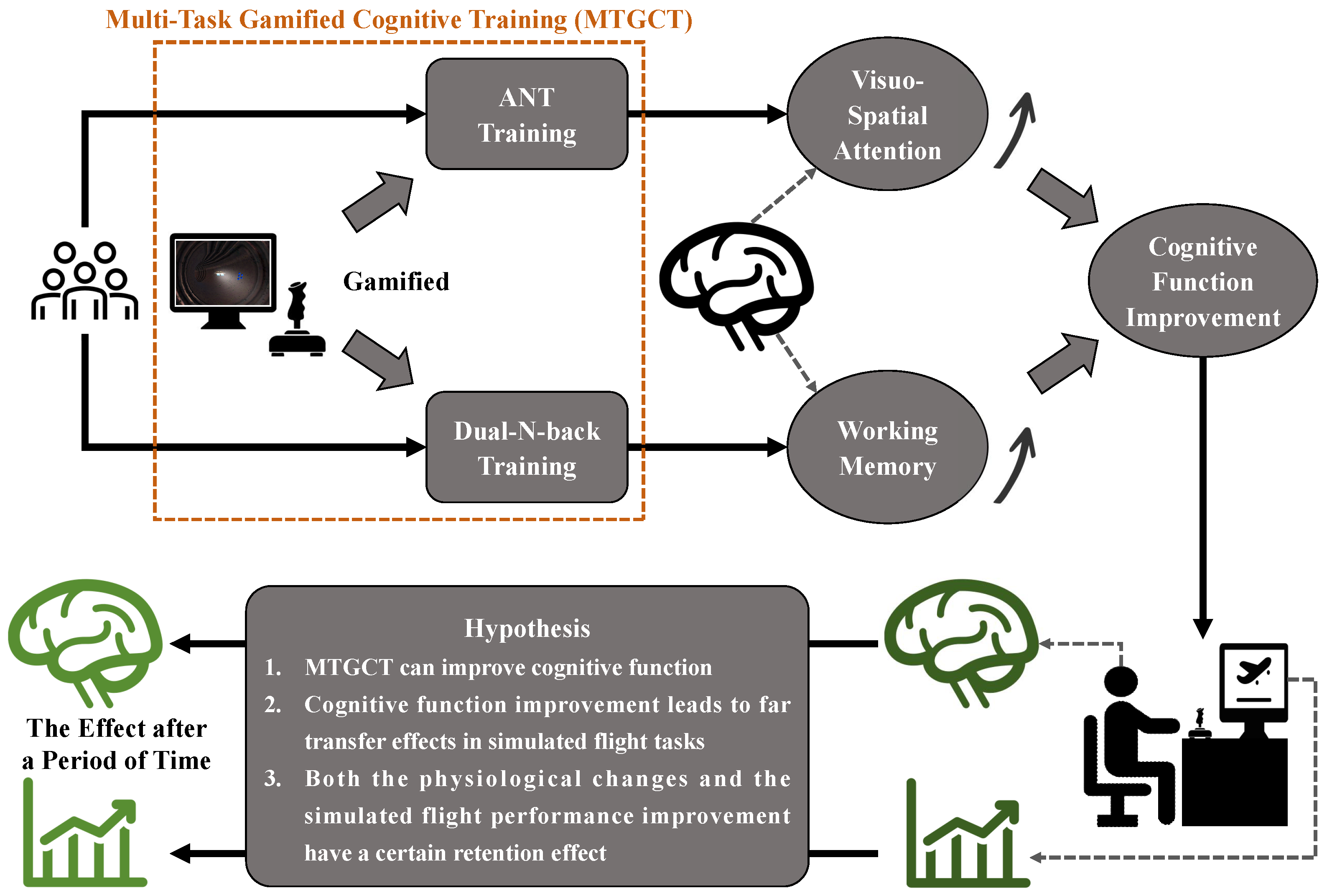

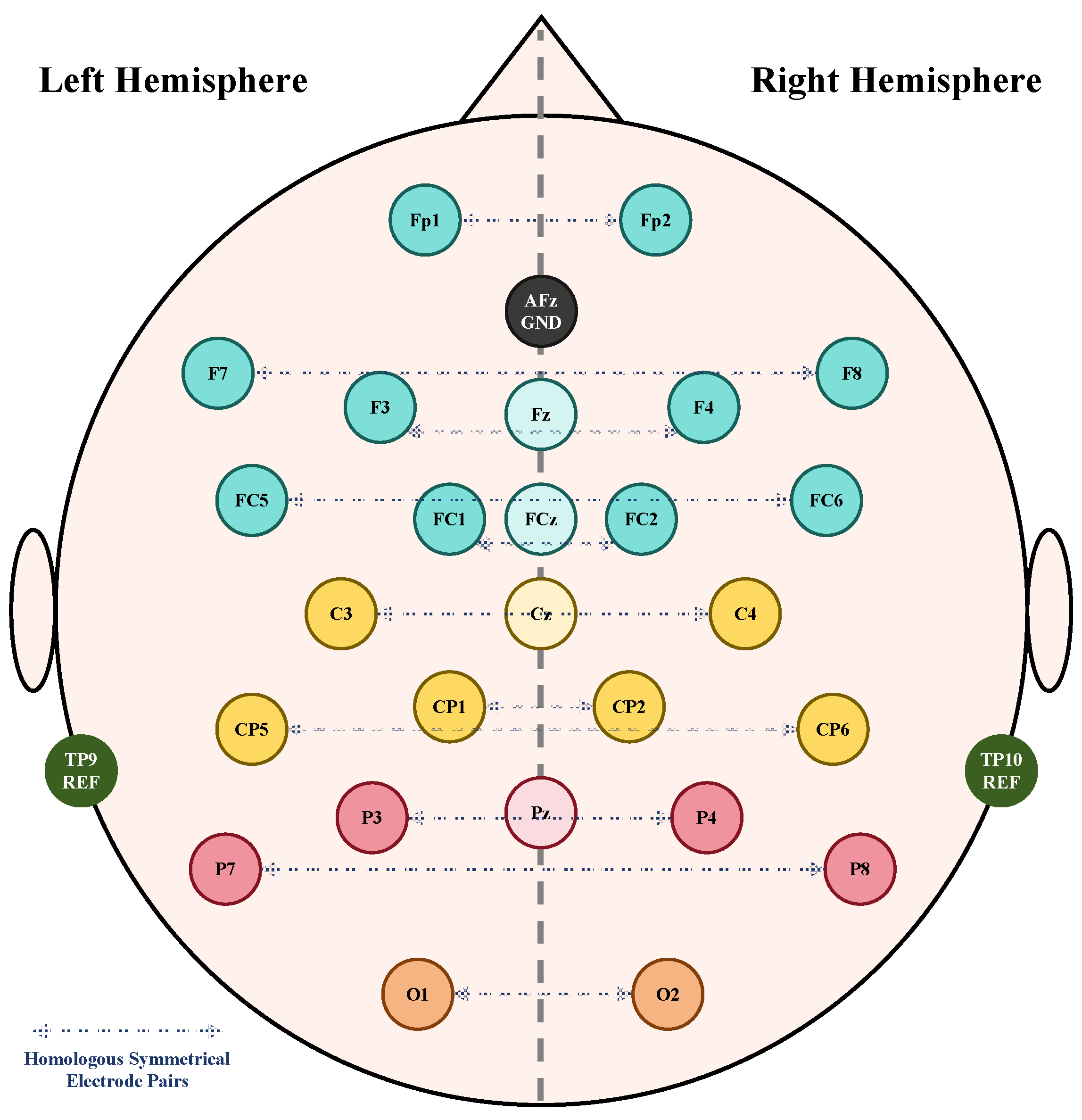
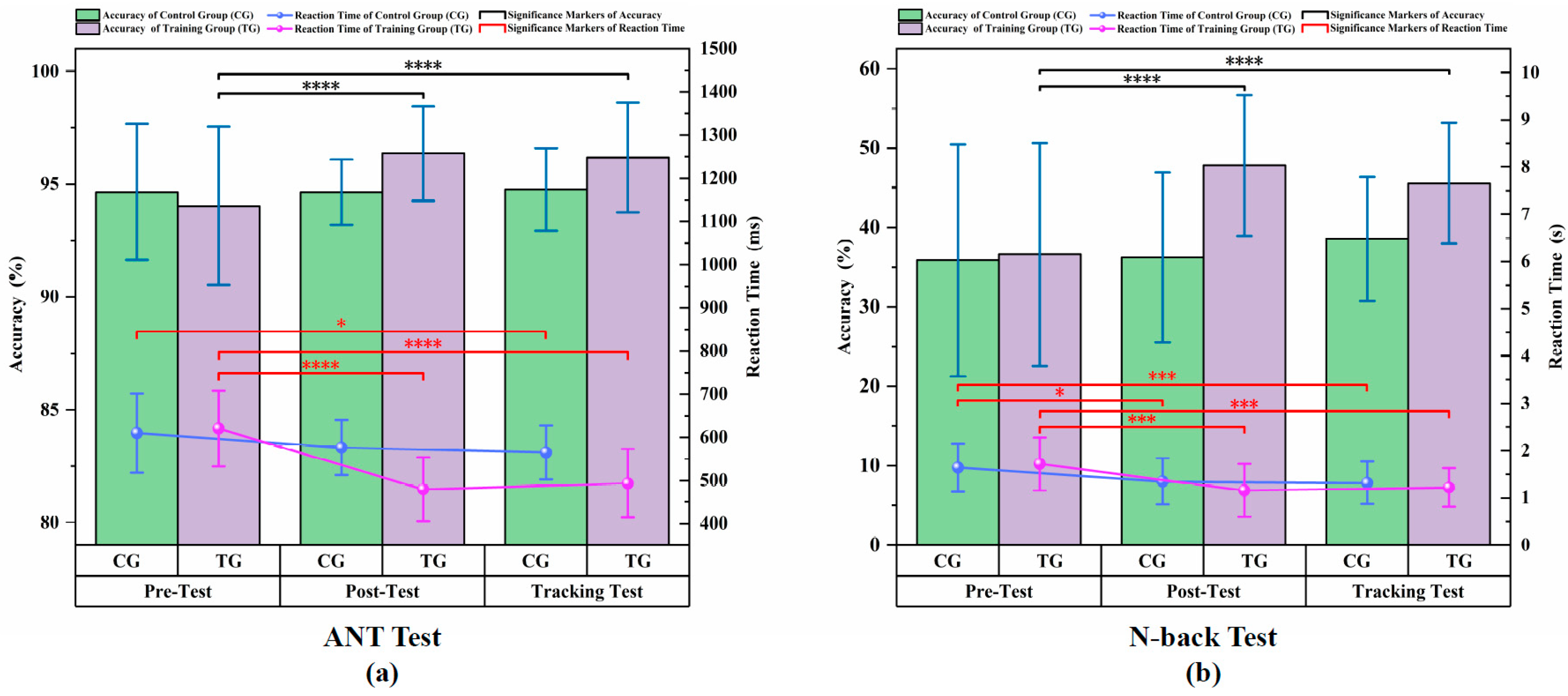

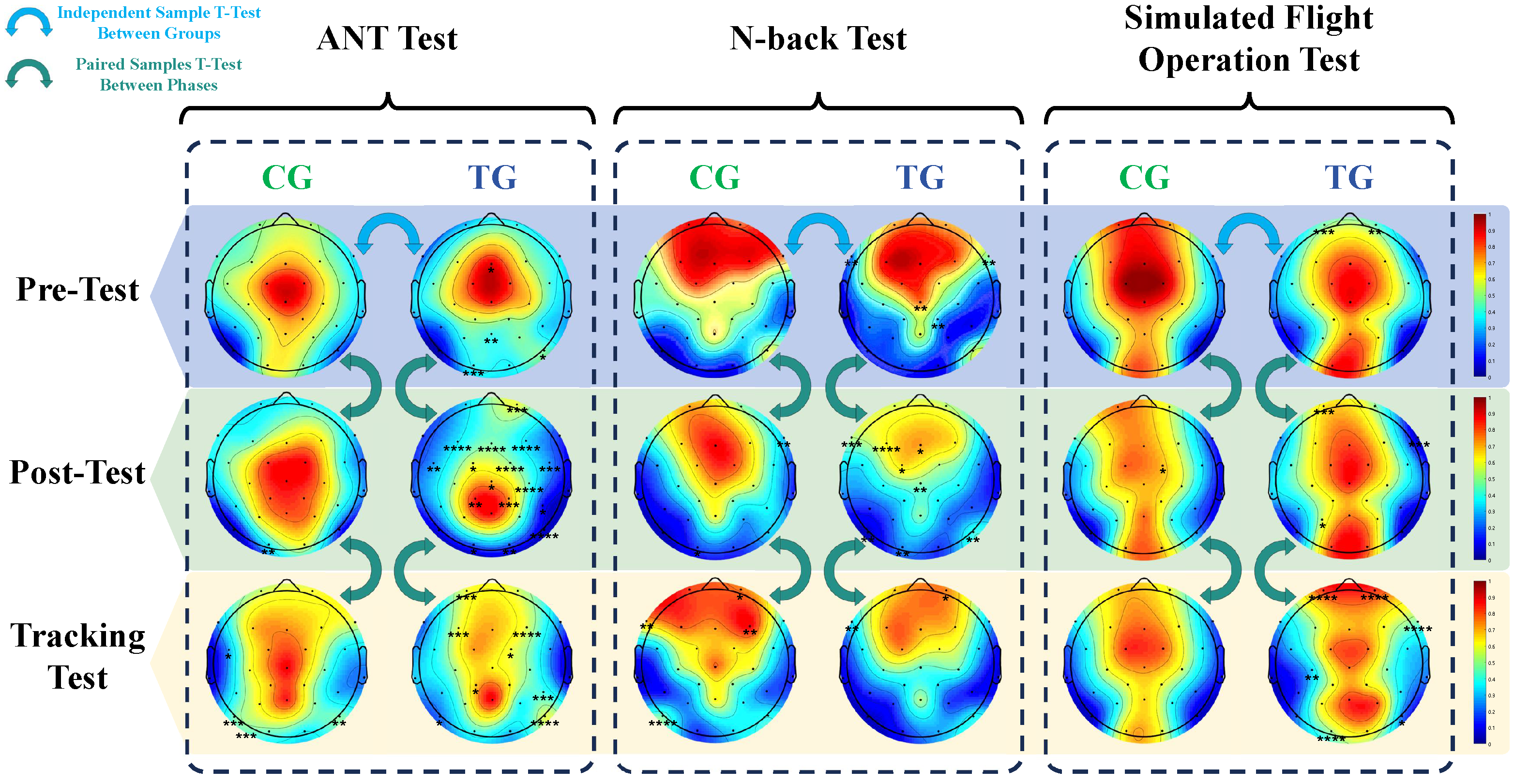
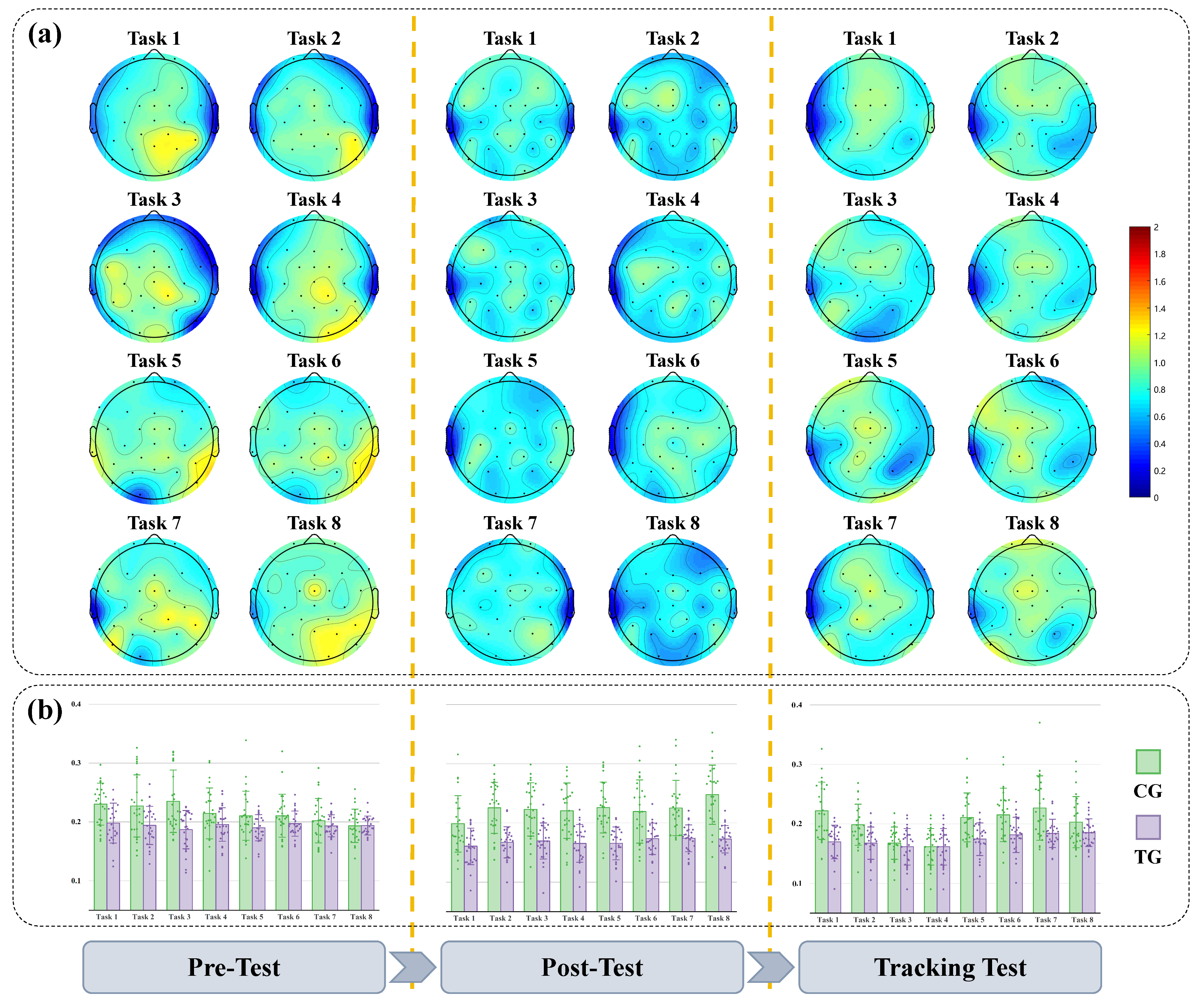
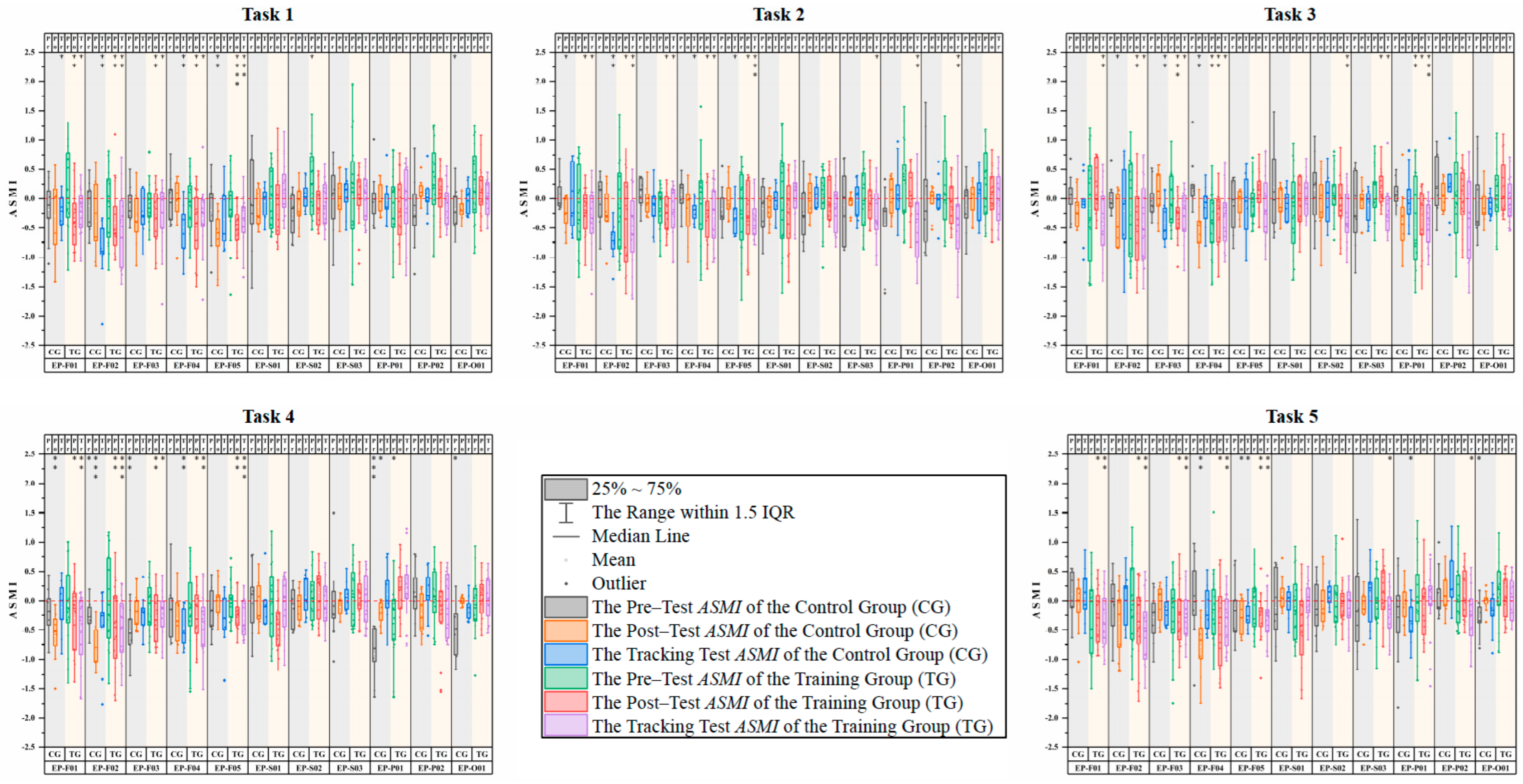

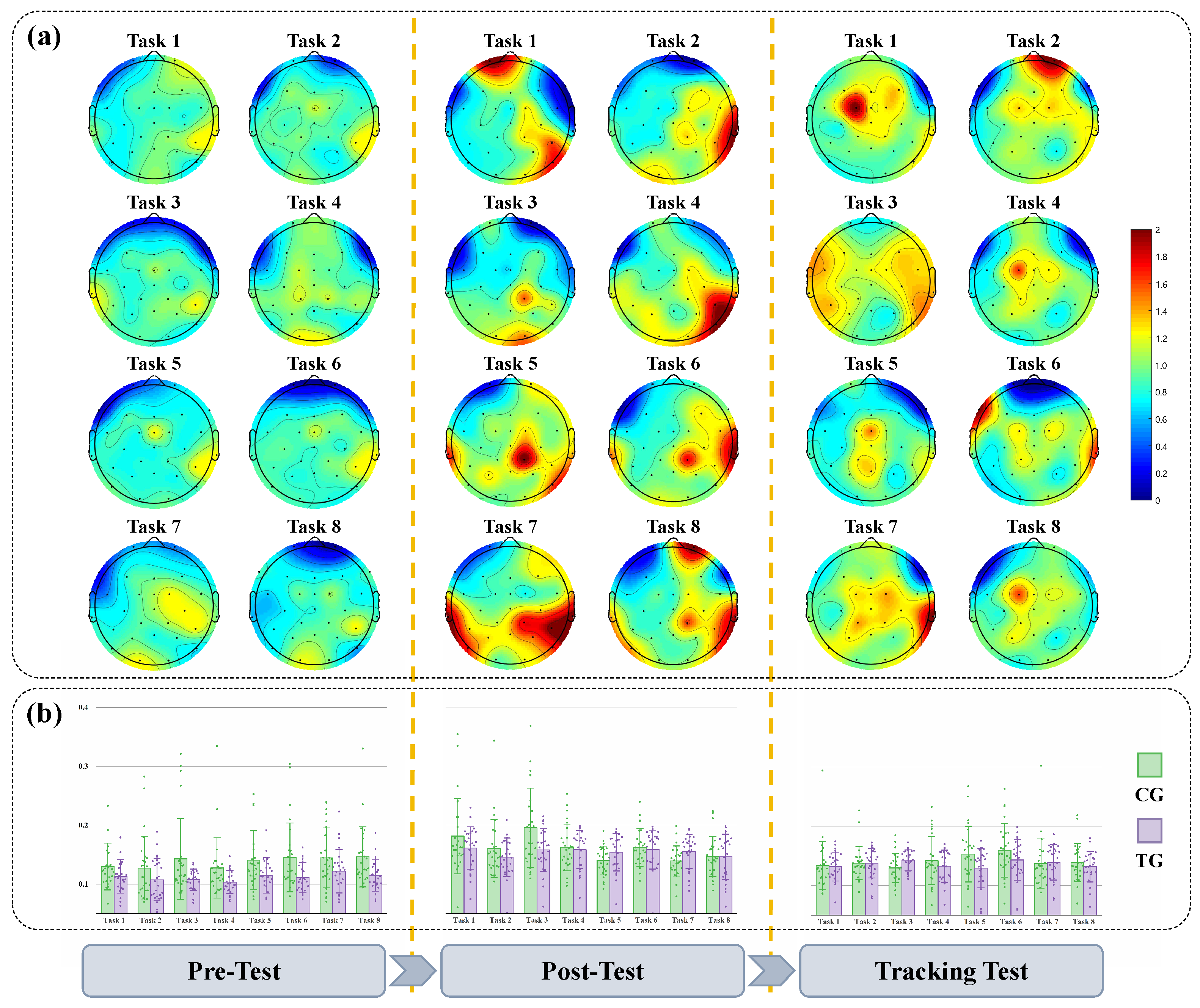


| Belonging Brain Region | Left Hemisphere | Right Hemisphere | Electrode Pair Number |
|---|---|---|---|
| Frontal | Fp1 | Fp2 | EP-F01 |
| F3 | F4 | EP-F02 | |
| F7 | F8 | EP-F03 | |
| FC1 | FC2 | EP-F04 | |
| FC5 | FC6 | EP-F05 | |
| Somatomotor | C3 | C4 | EP-S01 |
| CP1 | CP2 | EP-S02 | |
| CP5 | CP6 | EP-S03 | |
| Parietal | P3 | P4 | EP-P01 |
| P7 | P8 | EP-P02 | |
| Occipital | O1 | O2 | EP-O01 |
| Task | Grade | Group | Mauchly Test | Greenhouse- Geisser Correction | One-Way Repeated Measures ANOVA | Tukey Test | ||||||
|---|---|---|---|---|---|---|---|---|---|---|---|---|
| W | p-Value | F | p-Value | Pre vs. Post | Pre vs. Tracking | Post vs. Tracking | ||||||
| Task 1 | FT | CG | 0.7494 | 2.0190 | p = 0.3644 | No | F(2, 16) = 20.1625 | p < 0.0001 | 0.7159 | p < 0.05 | p < 0.0001 | p < 0.01 |
| TG | 0.5559 | 9.9826 | p < 0.01 | Yes | F(1.3849, 24.9286) = 87.2010 | p < 0.0001 | 0.8289 | p < 0.0001 | p < 0.0001 | p < 0.05 | ||
| OE | CG | 0.5005 | 4.8457 | p = 0.0887 | No | F(2, 16) = 10.6326 | p < 0.01 | 0.5706 | p = 0.0877 | p < 0.001 | p = 0.0802 | |
| TG | 0.2099 | 26.5373 | p < 0.0001 | Yes | F(1.173, 20.1109) = 32.1971 | p < 0.0001 | 0.6414 | p < 0.0001 | p < 0.0001 | p = 0.8360 | ||
| Task 2 | FT | CG | 0.9341 | 0.4774 | p = 0.7877 | No | F(2, 16) = 20.7936 | p < 0.0001 | 0.7222 | p < 0.0001 | p < 0.001 | p = 0.4862 |
| TG | 0.4607 | 13.1737 | p < 0.01 | Yes | F(1.2993, 23.3879) = 70.3690 | p < 0.0001 | 0.7963 | p < 0.0001 | p < 0.0001 | p = 0.5971 | ||
| OE | CG | 0.4388 | 5.7665 | p = 0.0560 | No | F(2, 16) = 5.0114 | p < 0.05 | 0.3852 | p < 0.05 | p = 0.1391 | p = 0.5282 | |
| TG | 0.6755 | 6.6688 | p < 0.05 | Yes | F(1.5100, 27.1803) = 55.1079 | p < 0.0001 | 0.7538 | p < 0.0001 | p < 0.0001 | p = 0.7460 | ||
| Task 3 | FT | CG | 0.9631 | 0.2630 | p = 0.8768 | No | F(2, 16) = 9.6304 | p < 0.01 | 0.5462 | p < 0.05 | p < 0.01 | p = 0.3563 |
| TG | 0.4400 | 13.9552 | p < 0.001 | Yes | F(1.2821, 23.0775) = 74.9872 | p < 0.0001 | 0.8064 | p < 0.0001 | p < 0.0001 | p < 0.05 | ||
| OE | CG | 0.4897 | 4.9981 | p = 0.0822 | No | F(2, 16) = 6.0235 | p < 0.05 | 0.4295 | p < 0.05 | p < 0.05 | p = 0.9239 | |
| TG | 0.3974 | 15.6901 | p < 0.001 | Yes | F(1.2479, 22.4628) = 39.2536 | p < 0.0001 | 0.6856 | p < 0.0001 | p < 0.0001 | p = 0.9872 | ||
| Task 4 | FT | CG | 0.7229 | 2.2711 | p = 0.3213 | No | F(2, 16) = 16.9581 | p < 0.001 | 0.6795 | p < 0.01 | p < 0.001 | p = 0.4151 |
| TG | 0.3981 | 15.6589 | p < 0.001 | Yes | F(1.2485, 22.4730) = 60.2832 | p < 0.0001 | 0.7701 | p < 0.0001 | p < 0.0001 | p = 0.0619 | ||
| OE | CG | 0.2162 | 10.7222 | p < 0.01 | Yes | F(1.1212, 8.9694) = 3.1571 | p = 0.0699 | 0.2830 | - | - | - | |
| TG | 0.4197 | 14.7593 | p < 0.001 | Yes | F(1.2656, 22.7806) = 60.4451 | p < 0.0001 | 0.7705 | p < 0.0001 | p < 0.0001 | p = 0.8841 | ||
| Task 5 | FT | CG | 0.9585 | 0.2971 | p = 0.8620 | No | F(2, 16) = 12.8779 | p < 0.001 | 0.6168 | p < 0.01 | p < 0.001 | p = 0.5980 |
| TG | 0.6430 | 7.5067 | p < 0.05 | Yes | F(1.4739, 26.5296) = 68.6504 | p < 0.0001 | 0.7923 | p < 0.0001 | p < 0.0001 | p = 0.2447 | ||
| OE | CG | 0.7146 | 2.3522 | p = 0.3085 | No | F(2, 16) = 3.9916 | p < 0.05 | 0.3329 | p = 0.2937 | p < 0.05 | p = 0.4330 | |
| TG | 0.6626 | 6.9966 | p < 0.05 | Yes | F(1.4955, 26.9181) = 23.8963 | p < 0.0001 | 0.5704 | p < 0.0001 | p < 0.0001 | p = 0.6357 | ||
| Task 6 | FT | CG | 0.3585 | 7.1804 | p < 0.05 | Yes | F(1.2184, 9.7473) = 14.9266 | p < 0.001 | 0.6511 | p < 0.001 | p < 0.001 | p = 0.9423 |
| TG | 0.6808 | 6.5359 | p < 0.05 | Yes | F(1.5161, 27.2896) = 74.2114 | p < 0.0001 | 0.8048 | p < 0.0001 | p < 0.0001 | p = 0.9989 | ||
| OE | CG | 0.4021 | 6.3776 | p < 0.05 | Yes | F(1.2516, 10.0131) = 4.8218 | p < 0.05 | 0.3761 | p < 0.05 | p = 0.0567 | p = 0.9453 | |
| TG | 0.5870 | 9.0566 | p < 0.05 | Yes | F(1.4154, 25.4776) = 23.4713 | p < 0.0001 | 0.5660 | p < 0.0001 | p < 0.0001 | p = 0.9531 | ||
| Task 7 | FT | CG | 0.7101 | 2.3960 | p = 0.3018 | No | F(2, 16) = 19.8175 | p < 0.0001 | 0.7124 | p < 0.01 | p < 0.0001 | p = 0.2626 |
| TG | 0.5974 | 8.7578 | p < 0.05 | Yes | F(1.4259, 25.6667) = 40.1103 | p < 0.0001 | 0.6902 | p < 0.0001 | p < 0.0001 | p = 0.9875 | ||
| OE | CG | 0.7613 | 1.9092 | p = 0.3850 | No | F(2, 16) = 8.8913 | p < 0.01 | 0.5264 | p < 0.01 | p < 0.01 | p = 0.9999 | |
| TG | 0.7586 | 4.6977 | p = 0.0955 | No | F(2, 36) = 102.3400 | p < 0.0001 | 0.8504 | p < 0.0001 | p < 0.0001 | p = 0.2673 | ||
| Task 8 | FT | CG | 0.7911 | 1.6403 | p = 0.4404 | No | F(2, 16) = 5.2577 | p < 0.05 | 0.3966 | p = 0.1522 | p < 0.05 | p = 0.4440 |
| TG | 0.4040 | 15.406 | p < 0.001 | Yes | F(1.2532, 22.5569) = 56.5552 | p < 0.0001 | 0.7586 | p < 0.0001 | p < 0.0001 | p < 0.05 | ||
| OE | CG | 0.6941 | 2.5557 | p = 0.2786 | No | F(2, 16) = 0.6902 | p = 0.5158 | 0.0794 | - | - | - | |
| TG | 0.7328 | 5.2858 | p = 0.0712 | No | F(2, 36) = 42.4158 | p < 0.0001 | 0.7021 | p < 0.0001 | p < 0.0001 | p = 0.8695 | ||
| Group | Phase | Simulated Flight Operation Tasks | Average | |||||||
|---|---|---|---|---|---|---|---|---|---|---|
| Task 1 | Task 2 | Task 3 | Task 4 | Task 5 | Task 6 | Task 7 | Task 8 | |||
| Band PSD Relative Band Ratio | ||||||||||
| Control Group | Pre-Test | 0.2302 | 0.2270 | 0.2350 | 0.2144 | 0.2104 | 0.2104 | 0.2020 | 0.1933 | 0.2153 |
| Post-Test | 0.1983 | 0.2252 | 0.2226 | 0.2204 | 0.2257 | 0.2191 | 0.2252 | 0.2476 | 0.2230 | |
| Tracking Test | 0.2219 | 0.1984 | 0.1675 | 0.1615 | 0.2108 | 0.2149 | 0.2265 | 0.2028 | 0.2005 | |
| Training Group | Pre-Test | 0.1980 | 0.1940 | 0.1868 | 0.1956 | 0.1900 | 0.1970 | 0.1932 | 0.1938 | 0.1935 |
| Post-Test | 0.1603 | 0.1672 | 0.1693 | 0.1653 | 0.1653 | 0.1731 | 0.1739 | 0.1724 | 0.1684 | |
| Tracking Test | 0.1696 | 0.1675 | 0.1615 | 0.1615 | 0.1743 | 0.1815 | 0.1839 | 0.1851 | 0.1731 | |
| Band PSD Relative Band Ratio | ||||||||||
| Control Group | Pre-Test | 0.1301 | 0.1274 | 0.1431 | 0.1277 | 0.1407 | 0.1456 | 0.1447 | 0.1466 | 0.1383 |
| Post-Test | 0.1814 | 0.1602 | 0.1956 | 0.1623 | 0.1399 | 0.1621 | 0.1392 | 0.1470 | 0.1610 | |
| Tracking Test | 0.1337 | 0.1376 | 0.1296 | 0.1420 | 0.1530 | 0.1591 | 0.1370 | 0.1388 | 0.1414 | |
| Training Group | Pre-Test | 0.1134 | 0.1077 | 0.1078 | 0.1038 | 0.1151 | 0.1112 | 0.1222 | 0.1147 | 0.1120 |
| Post-Test | 0.1612 | 0.1456 | 0.1579 | 0.1584 | 0.1541 | 0.1585 | 0.1556 | 0.1464 | 0.1547 | |
| Tracking Test | 0.1319 | 0.1377 | 0.1429 | 0.1324 | 0.1295 | 0.1430 | 0.1390 | 0.1318 | 0.1360 | |
Disclaimer/Publisher’s Note: The statements, opinions and data contained in all publications are solely those of the individual author(s) and contributor(s) and not of MDPI and/or the editor(s). MDPI and/or the editor(s) disclaim responsibility for any injury to people or property resulting from any ideas, methods, instructions or products referred to in the content. |
© 2025 by the authors. Licensee MDPI, Basel, Switzerland. This article is an open access article distributed under the terms and conditions of the Creative Commons Attribution (CC BY) license (https://creativecommons.org/licenses/by/4.0/).
Share and Cite
Ding, P.; Li, C.; Zhou, Z.; Xiang, Y.; Wang, S.; Song, X.; Li, Y. Far Transfer Effects of Multi-Task Gamified Cognitive Training on Simulated Flight: Short-Term Theta and Alpha Signal Changes and Asymmetry Changes. Symmetry 2025, 17, 1627. https://doi.org/10.3390/sym17101627
Ding P, Li C, Zhou Z, Xiang Y, Wang S, Song X, Li Y. Far Transfer Effects of Multi-Task Gamified Cognitive Training on Simulated Flight: Short-Term Theta and Alpha Signal Changes and Asymmetry Changes. Symmetry. 2025; 17(10):1627. https://doi.org/10.3390/sym17101627
Chicago/Turabian StyleDing, Peng, Chen Li, Zhengxuan Zhou, Yang Xiang, Shaodi Wang, Xiaofei Song, and Yingwei Li. 2025. "Far Transfer Effects of Multi-Task Gamified Cognitive Training on Simulated Flight: Short-Term Theta and Alpha Signal Changes and Asymmetry Changes" Symmetry 17, no. 10: 1627. https://doi.org/10.3390/sym17101627
APA StyleDing, P., Li, C., Zhou, Z., Xiang, Y., Wang, S., Song, X., & Li, Y. (2025). Far Transfer Effects of Multi-Task Gamified Cognitive Training on Simulated Flight: Short-Term Theta and Alpha Signal Changes and Asymmetry Changes. Symmetry, 17(10), 1627. https://doi.org/10.3390/sym17101627







